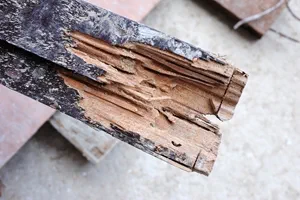
If you see particularly large ants around your doorways or on your back porch, they may be carpenter ants. These aren't the tiny ants that you encounter under mounds of sand when you're gardening. Carpenter ants can be destructive to your home's structure, and you can't afford to ignore them.
When you're spending more time outdoors fixing up your yard, take time to inspect the wooden features of your home. While carpenter ants don't eat wood, they like to burrow into it wherever they can find a rotted area like moisture-damaged wood under eaves, around chimneys, in doors and door frames, beneath wooden siding and shingles, and inside wood porch supports and columns.
By spraying a bug barrier around your doors, foundation and along the supports of your porch, you may be able to block a few stray carpenter ants from entering your home. But if you encounter an infestation, their presence can be widespread and may be housed in several locations. They may actually have created nests inside your home. In those cases, it's best to consult with the professionals. Companies like Abell Pest Control Services can do a pest inspection and determine the best course of action.
Carpenter ants often aren't hard to miss because of their size, which can be as big as 1/2 inch in length. But not all carpenter ants look alike, either. Some are small, they can vary in color, and some are winged while others can't fly. Typically, the ones that homeowners encounter are black, wingless and large.
They're a varied lot, attracted to wood outdoors and sometimes inside, but also to certain foods you may leave out on your kitchen counters. Carpenter ants are partial to sweet foods and meat, which is why homeowners should store foods in sealed containers just as they do as part of good pest management against any insects.
However, in warm weather most carpenter ants can be found outdoors. There, homeowners should be diligent about limiting the ants' access by moving woodpiles and other large pieces of wood away from their houses, cutting back tree limbs that overhang houses and sealing any foundation cracks, gaps around doors and windows and entry points of utility wires into their homes. Don't overlook skylights or chimneys, because if carpenter ants want to find a way into your home, they'll enter any opening they can.